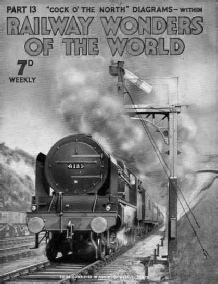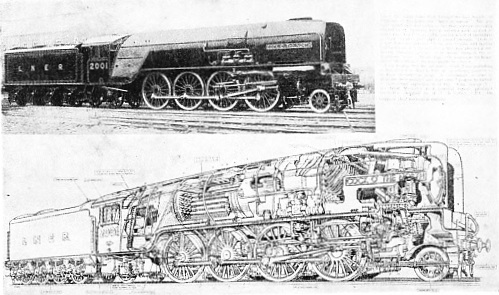
© Railway Wonders of the World 2012-


Editorial to Part 12


NEXT week we shall continue the chapter begun in this part on the operation of the Vacuum Brake. The explanation of this most important item of railway equipment will then be completed.
A special feature of Part 13 (on sale next Friday) will be a brilliant chapter on the Railways of India. Throughout India the Government exercises direct or indirect control over all the railways through a Railway Board. Private railways and large companies now more or less form one great unit operating over 42,000 miles of track.
AMONG other chapters I shall include one on the famous LNER express engine, “Cock o’ the North”, recently so much before the public eye after its trials on the locomotive-
THE beginning of the story of the London and North Eastern Railway will also appear in Part 13. The company, which came into operation in 1923, consists of the former Great Eastern, Great Northern, and many other well-
THIS week’s cover (Part 12) is a night-
M.V.T. (Wembley Park) raises that oft-
ANOTHER letter, this time from G.N. (Southend), presents this question: “What happens when a rich man telephones to a railway company and says that he wants a special train for himself and his staff to travel on a certain day, say, from London to Cardiff?” Well, I have never been able to do this myself, since it is a privilege of millionaires, and the answer to the question would take too much space in this, my personal page; but G.N. will later find a complete chapter on special trains of this nature. It is, in fact, a fascinating sidelight on one of the many odd problems which the railways are from time to time called upon to face.
K.R.N. (Leeds) has asked when a chapter on the railway in Scandinavia will appear, as he is especially interested in that part of the world. My correspondent will find in Part 13 a long complete chapter about the railway in the land of the midnight sun -
 Readers who have followed me thus far in this fascinating work should, if they have not already done so, place a standing order with their newsagents to ensure regular delivery.
Readers who have followed me thus far in this fascinating work should, if they have not already done so, place a standing order with their newsagents to ensure regular delivery.
NEXT WEEK:
PART 13 ON SALE APRIL 26
“Cock o’ the North”, mighty “Mikado” type locomotive of the London and North Eastern Railway, cannot be compared with any other express designs. It is unique.
On Friday next we shall place in your hands a description of this great locomotive in detail -
The “Cock o’ the North” has recently returned from France after undergoing trials on the great locomotive testing machine at Vitry-

This
SUPERB
Diagram
In
Photogravure
A WORD ABOUT PART 14, TOO
The following week, in Part 14, we shall be showing a striking coloured plate of yet another giant engine, this time at the head of that famous American express, the “Twentieth Century Limited.”
Part 14 will also contain a second coloured picture showing the “Flying Scotsman” leaving King’s Cross on its journey to the North.

